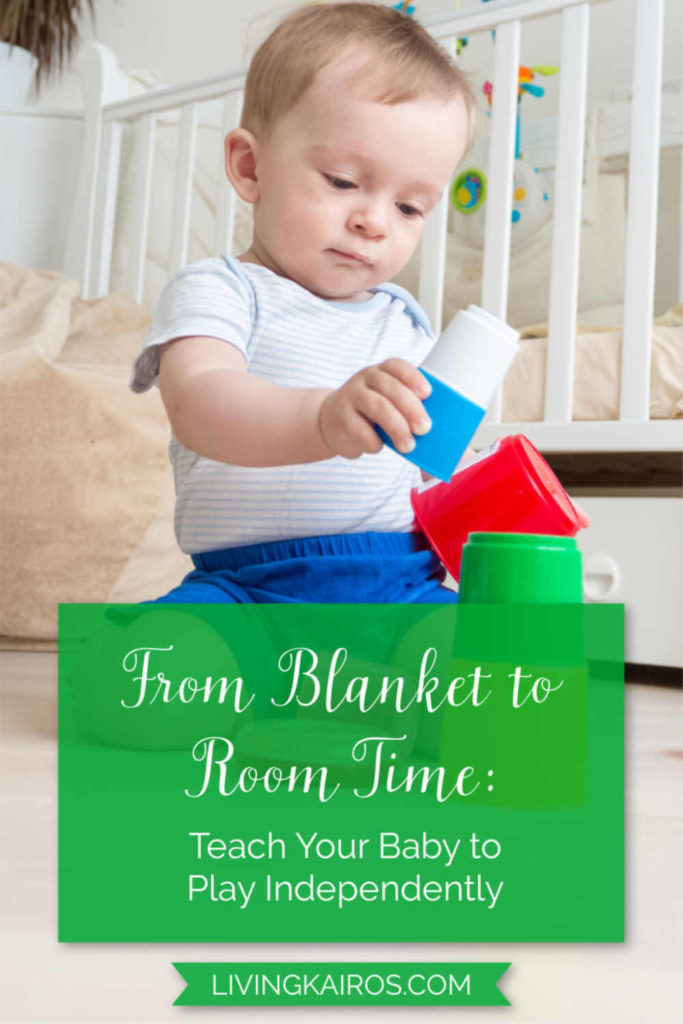As a mom, do you ever crave a moment to yourself? Perhaps you feel guilty for wishing your little one could play alone for a few minutes. Of course, babies need a lot of attention and should not be left unsupervised, but learning to play alone is a crucial part of their development. And guess what? You don’t have to wait until he or she reaches preschool-age to teach your baby to play independently! And if you stick with it, your child will learn to enjoy and even ask for it. Plus, you can have a few minutes to enjoy couch time with your spouse, do the dishes, read a chapter in your book, or even shower (say what?).

What is independent play?
Independent play is pretty much what it sounds like: the child plays independently, outside of view of mom and dad. While leaving your little one on his own may sound a little scary, teaching your baby to play independently will yield a lifetime of benefits.
Blanket or Room Time
If you’ve been around Living Kairos for any length of time, you know I am a huge fan of the book On Becoming Babywise. We used this book to learn how to get our babies on a schedule, and they are both excellent sleepers most of the time. But the authors didn’t stop at infancy; they have an entire series of books that help parents learn practical ways to teach and guide their children from birth until the teenage years.
Needless to say, we are huge fans, and are very grateful to have discovered these tools. We first learned about how to teach our baby to play independently in the second book in the series, Babywise II, which addresses development in children ages six to twelve months.
While the book has tons of useful information, one of the things that helped us the most was the idea of independent play, called “Blanket Time” or “Room Time” in the book. Both my husband and I have each said on multiple occasions that this strategy was one of the best things we implemented with our kids, and you will see why.
Why teach your baby to play independently?
When you implement blanket or room time every day, your child learns structure and routine. This helps him trust you as his parent and provides a level of security that he doesn’t necessarily understand, but feels, nonetheless.
When you teach your baby to play independently, you also implement boundaries, first with a blanket, then a playpen, and eventually a large space like a bedroom or playroom.
How to teach your baby to play independently
Babywise II goes into much more detail on the ins and outs of teaching independent play (so I highly recommend you read it), but this is how we implemented the principles with our babies. We waited (after a false start) to teach Little Man to play independently until he was around 18 months, and I wish we would have started sooner. We started blanket time with our daughter, Little Miss, at about six and a half months. In our experience, it’s much easier to teach a baby than a toddler (although it’s not impossible with an older baby or toddler!).
Babies
You can begin teaching your baby to play independently around six months. By then, he is probably learning to roll over, and may even begin sitting up with support.
Start with just five minutes of blanket time per day, and work up from there. Place your baby on a large blanket or mat in a safe area. Make sure there is nothing dangerous on the floor that he might put in his mouth (I suggest these baby-proofing basics).
Create an engaging environment: set out simple, fun toys that will hold your baby’s interest. Little Miss enjoys her Montessori ball (similar to this sensory clutch ball), wooden teethers, wooden teether with ribbons, interlocking discs, and Skwish rattle.





Little Miss has around fifteen minutes of blanket time per day (she’s about seven and a half months now). She can sit unsupported, but still tips over from time to time, so if I give her sitting blanket time, I use a Boppy to help support her, just in case. If she has blanket time laying down, I make sure none of the toys are heavy enough to hurt in case she accidentally drops them on her face.

Teach your baby to play independently at a time of day that works for you. I let Little Miss have blanket time while I prepare breakfast. Our playroom is located just off the kitchen, so I place her in an area where I can hear her and peek in every couple minutes to make sure she’s doing okay.
Once your baby is mobile (creeping or crawling), you may decide to transition from a blanket to a playpen. We have this Pack ‘n Play, which we plan to use with Little Miss in a couple months. Alternately, you can use a gate-style playpen (we have one similar to this play yard that we used when our dogs were puppies, and may use it if Little Miss doesn’t like the Pack ‘n Play. Whatever you use, make sure it’s a safe, fun space for your baby to entertain herself.


How to handle resistance from baby
When you begin to teach your baby to play independently, there will be some pushback at first. After all, your little one loves you and wants to be near you. She may cry as soon as you are out of sight. This is normal! Wait for a few minutes to see if she calms herself down. If she doesn’t, go to her, give her a hug or kiss on the cheek, show her that she has toys to play with, and tell her, “Mama will be right back.” Leave once again and see what happens.
You may need to do this a few times. Don’t give up! And if your first day doesn’t go how you planned, try again the next day. Don’t count it as a failure; it’s a valuable learning experience for both of you.
If she still resists after a few days, consider changing the location of her blanket time. She may enjoy a change of scenery. Perhaps you can place her in another room, or in front of a glass door so she can see outside. Get down on her level to see what she sees.
Also, consider changing out her toys. Perhaps she would enjoy something different. It can feel discouraging when you seem have the same struggle days in a row. But keep at it and eventually she will get it. I initially tried introducing playpen time with Little Man when he was around twelve months old, and because I wasn’t consistent, he did not do well. Instead of keeping at it, I gave up and didn’t try again for six months. I wish I would have stuck with it instead of caving, but, as you can see in the next section, you can still teach your baby to play independently when they are older, even toddlers!
Older babies and toddler
It’s absolutely possible to teach your baby to play independently if he is a little older! It may seem a little more difficult, but it can be done. As I mentioned above, we restarted room time with Little Man when he was around eighteen months. We moved him from the nursery to his own room with a bed when he was sixteen months because he started climbing out of the crib (plus, we were expecting our new baby and wanted to get him used to it before she came).
He had a hard time because he was used to being with me pretty much all the time except when he slept. I absolutely love and cherish that time I had with him, but I definitely needed a little break each day to get things done, sip a cup of coffee uninterrupted, or just catch my breath for a few minutes.
Begin teaching your baby to play independently by creating an inviting place to play that isn’t overwhelming. I put a few of my son’s favorite toys in the middle of his room and turn on some music for him to listen to while he plays. Make sure the space isn’t overcrowded with too many toys, but add enough so he won’t get bored. Keep the music on a low volume, and make sure he has plenty of good light.
Invite your child into the space and show him the toys. Ask him to listen to the music, and even sing along for a song or two. Set a timer (we bought a kitchen timer similar to this one) for ten to fifteen minutes, and explain that he will play in his room until the timer goes off. Demonstrate what the timer sounds like so he knows what to expect. I always say, “Have fun playing! I’ll be back when the timer goes off,” and close the door.
How to handle resistance from your older baby or toddler
The key to teaching your baby to play independently is consistency. If your child resists (which he likely will at first), you have to stick with it. I know it’s hard, mama! I’ve been there. If he cries, let him cry for a few minutes; it won’t hurt him (it will probably hurt you more!). Then go in, give him a hug and redirect his interest in the toys.
Demonstrate how he can play with the toys and get him engaged. Then, show him the timer and remind him it will make a fun sound when it’s time to finish playing. I say something like, “Look, you only get to play for five more minutes! Let’s get settled so you can enjoy playing before it’s time to finish.”
Remember, consistency is key. Do it every, single day—even if he only stays for five minutes. Those five minutes will turn into ten, until he’s playing for an hour by himself. Little Man knows our morning routine consists of breakfast, family devotions, and room time. When family devotions are over, he excitedly proclaims, “Now room time!” and runs to his room. He learned to value that time by himself, and he can explore his imagination freely without the confines of a structured activity.
This whole independent play thing might seem hard at first, but stick with it, mama! Your job is not to entertain your child 24/7; your job is to raise children who will grow into independent adults. Stay consistent, make it fun, and enjoy the fruits of your labor.





